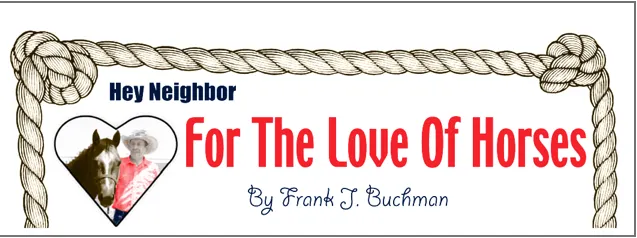By Frank J. Buchman
“It takes just 25 minutes to train a horse to ride, and do more than most people would ever expect from their mount.”
That’s a true story as concise and complete as can be said.
The coming two-year-old bay Dash For Cash bred gelding had been handled, so Scott Daily led him into the round pen with a black rope halter that had a long rope attached.
Just before 12:30, several dozen watchers had scattered into the bleacher seats at Topeka’s Domer Arena to see which the best was: cowboy or horse?
“A tie” verified the spectators at five ’til 1, with most appreciative applause.
Scott Daily proved to be the renowned horseman which he’s acclaimed, and the young gelding couldn’t have done any better, those watching agreed.
The presentation was kickoff of a half-dozen such “horse-starting” seminars given by the Arkansas City cowboy-horse trainer during the three-day annual Topeka Farm Show.
In a return engagement at this particular event, actually for several years, Daily conducts similar clinics throughout the year around the Midwest, in addition to training many horses annually out of his Cowley County stables.
Having seen the obviously-knowledgeable, humble horseman work before, one must appreciate his most apparent common horse sense, respect for the animal to be trained.
“We have to get him used to me, the crowd, this pen, and moving,” explained Daily, with a portable microphone attached under his hat,
Coaxing through verbal clucks, shaking the rope, even softly touching the horse’s hip, the horseman moved the gelding away and around the pen.
“These clods are a bit rough,” evaluated the cowboy, as the colt stumbled once, as being asked to pick up speed, and do two gait transitions.
Responding to Daily’s tension on the line, the gelding faced him, for a kind pat on the nose, before being directed to move at a walk, jog and lope to the right. “The horse must be worked the same on both sides, so he doesn’t become ‘one-sided,’ and is used to everything,” Daily said.
Again, the colt was tugged to the trainer gently, for a “thank-you” pat, and Daily’s verbal: “Very good.”
Standing in the pen with the gelding, Daily put the rope around the horse’s heart girth, snugged it slightly.
“He needs to get used to pressure around his middle,” noted the trainer, as moving the rope into the gelding’s flank area, which created vague irritation, and apparent flinching.
“It’s okay. Good,” Daily complimented the young horse’s quick relaxation to the actions, new and strange to him.
Rubbing the bay affectionately, Daily put the rope over the colt’s back and down his hip, even around front and back legs and feet, tightening and tugging softly. Exact maneuvers were repeated on the opposite side. “Nice job,” Daily credited.
The horse was pulled in a tight circle toward the trainer both directions, as Daily explained, “This gelding has to learn to give to pressure and follow his nose. Very good.”
Standing on the horse’s left side looking at the wither, Daily stretched his body over the gelding’s back, and soon his spur-strapped-boots were inches off the ground. “He has to get used to weight on is back, and learn to balance himself.”
Going to the right side, same “weight-balance” exposure was readily accepted by the bay gelding. “He’s ready to see the saddle,” Daily evaluated.
First taking a saddle pad from the fence, Daily rubbed it all over the horse on both sides, and placed it in position on the colt’s back.
An apparent-heavy, dusty, Western stock saddle with loosely-coiled lariat attached was tugged from the round pen fencing.
“You’re okay. Nothing’s going to hurt you,” Daily assured the gelding as he fidgeted, rolled his eye, and laid both ears back momentarily.
Permitting the colt to smell tack, and moving it all around him as possible, the saddle was placed over the previously positioned pad, jarred back and forth on the gelding’s back.
The trainer pulled both front and rear saddle cinches into their buckles, putting snug pressure on both, before loosening, and then retightening more.
“I have to get the saddle tight enough so if he takes off the saddle doesn’t turn or come off, scare him, and create more problems,” informed Daily, 12 minutes after entering the pen.
Continuing to snug both girths, the trainer shifted the saddle gently on the gelding’s back, and soon asked him to move away around the pen. Arching his back just a bit initially, the bay soon moved freely, as Daily pried for more speed, eventually a canter.
“Good job,” credited trainer, tugging the gelding lightly, seeking reversed direction, and moving the young horses into requested gaits, quite freely actually. “I think he’s about ready to ride,” Daily critiqued.
On the horse’s left side, the cowboy put his boot in the stirrup, some pressure, and stepped up into the saddle, seated himself just a jiffy and was back off, repeating the action a couple of times, before duplicating training on the gelding’s right.
Tying the lead rope around in rope-reins formation to the horse’s halter, and stringing the long rope through his own belt loop, Daily retightened the cinches.
Pulling his hat down firmly, the trainer stepped up from the left stirrup into the saddle, settled momentarily, squeezed his lower legs, and asked the gelding to move.
Slow and cautious initially, and then with a quick lunge, the bay colt moved forward, soon freely, as rider asked for more speed, a trot, and canter with coaxing from hand and horned-lariat tap.
“Good, now he has to go the other way,” again Daily complimented, as he reversed his mount, moving freely, into a trot and persuaded canter.
Riding around for a couple of minutes both directions, Daily asked the mount to stop and go, and turn tightly both directions.
“He’s sure taking this good,” trainer evaluated.
Lariat was unlatched from the saddletree, swung around the horse’s head, creating a wide eye, horse’s forward movement into the air, but soon the colt-in-training was again cool and collected.
“I have to get him familiar with the rope around his legs when I’m on him,” demonstrated Daily, catching all feet separately.
Looping the lariat back to saddle, the trainer picked up a long black bullwhip from the fence, swung it, then cracked a “snap” that shocked his mount the first time, but the bay soon was taking all in stride. “He’s a good horse,” horseman said.
Pulling his mount into square position, Daily stood up in the saddle, tipped his hat to the bleacher crowd, reaping approving applause, exactly 25 minutes after beginning.
“This is a great colt, but he’ll still need lots of riding before he’s a completely trained horse,” Scott Daily concluded.



